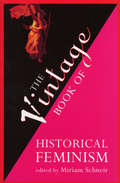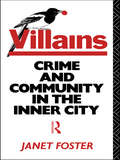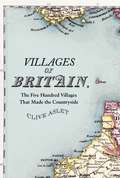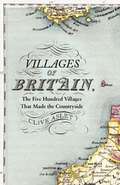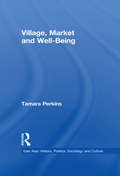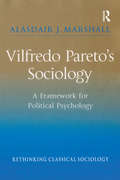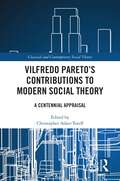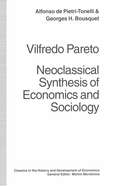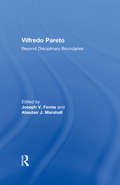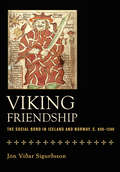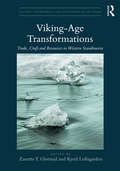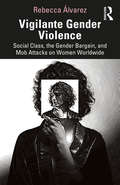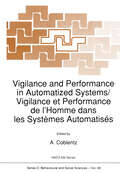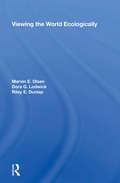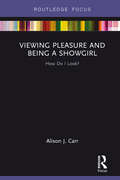- Table View
- List View
The Vintage Book Of Historical Feminism
by Miriam SchneirHere are the essential historical writings of feminism. Many of the works, long out of print or forgotten in what Miriam Schneir describes as a male-dominated literary tradition, are finally brought out of obscurity and into the light of contemporary analysis and criticism. Included are more than forty selections, covering 150 years of writing on women's struggle for freedom - from Mary Wollstonecraft and George Sand to Emma Goldman and Clara Zetkiln.
Villains - Foster
by Janet Foster"Villians" provides a rare insight into local and family traditions of petty crime. It looks at attitudes to crime and law enforcement, and the relationship of those attitudes to the culture in which they are expressed. This book should be of interest to students and teachers in police studies, ethnomethodology and women's studies.
Villains - Foster
by Janet Foster"Villians" provides a rare insight into local and family traditions of petty crime. It looks at attitudes to crime and law enforcement, and the relationship of those attitudes to the culture in which they are expressed. This book should be of interest to students and teachers in police studies, ethnomethodology and women's studies.
Villages of Britain: The Five Hundred Villages that Made the Countryside
by Clive AsletVillages of Britain is thehistory of the countryside, told through five hundred of its mostnoteworthy settlements. Many of Britain's villages are known for theirloveliness, of course, but their role in shaping the nation over thecenturies is relatively untold, drowned out by the metropolitan bias ofhistory.A consummate storyteller, Clive Aslet deftly weaves the worlds ofagriculture, politics, the arts, industry, folklore, science, ecology,fashion and religion into one irresistible volume. The Bedfordshireworks that a century ago manufactured half a billion bricks a year; theCheshire municipality striving to become the country's firstcarbon-neutral community; the Derbyshire estate where the cottagesrepresent the gamut of European architecture; the Gloucestershirecommunity founded by Tolstoyans, who still live by anarchic principles;the Leicestershire town where pub walls are embedded with Jurassic-erafossils; the Morayshire settlement where Hogmanay is celebrated elevendays late; the Pembrokeshire fishing hamlet that inspired Dylan Thomas;the Somerset village that was built on the back of the trade inPeruvian bird droppings; the Suffolk village that is rejectingmodernity by reconstructing a windmill for grinding flour; the Surreywoodland that fosters Europe's most ancient trees - all these areplaces that have made a unique contribution to the narrative of thiscountry.Follow Clive Aslet in visiting all five hundred villages, and you willhave experienced the history of these islands from a uniquely ruralperspective.
Villages of Britain: The Five Hundred Villages that Made the Countryside
by Clive AsletBritain's villages are world famous for their loveliness and idiosyncratic charm. Each village is different; travel across the country and you will unearth a joyous variety, from straggly Leintwardine in Herefordshire to BBC-film-perfect Askrigg in Yorkshire to higgledy-piggledy tourist hub Polperro in Cornwall to Miserden in Gloucestershire, with its staggeringly beautiful gardens, to Pittenweemin Fife, still eking a living from fishing, to the warring villages of Donhead St. Mary and Donhead St. Andrew in Wiltshire. History and architecture account for some differences-the memorials in churches, the details of door frames and chimney stacks-but there are also differences of spirit, and in how life is lived there today. What are the thriving local businesses? What are they selling in the shops-or are there shops at all? What are the traditions, old or invented? Who are the people who make these communities work?In this captivating volume, Clive Aslet draws on thirty years of travel in the countryside working for Britain's Country Life magazine to give us a living, personal, and opinionated history of five hundred of Britain's most beautiful and vibrant villages. Meticulously researched and drawing from conversations with local residents, publicans, and vicars, this book is both an indispensable gazetteer for anyone planning to tour the countryside and a portrait of rural Britain in a time of change.
The Villager: How Africans Consume Brands
by Feyi OlubodunThe Villager is essential reading for brand owners wishing to conquer new markets.When Feyi Olubodun, CEO of one of West Africa’s leading creative agencies, witnessed one too many cases of brands failing in the African marketplace he began to ask himself questions: Why did brands, both global and local, so often fail to connect with the African consumer? And, what was it about the African market that brand owners were not seeing?He began to reflect on his own marketing experiences and out of this emerged the framework for The Villager. In Feyi’s view, the African consumer begins his life’s journey by moving from the village, his rural dwelling, to the city, carrying with him not only his own dreams but also the dreams of his community. He is a highly aspirational consumer, motivated to succeed, and he becomes the economic portal for the rest of his community back home. But although he may be exposed to global influences and technology, his essential identity remains largely intact. This is why Feyi calls the African consumer a Villager. The Village is no longer a physical space; it is a psychological construct that defines him and the filter through which he engages with and consumes brands.In developing his construct, Feyi posits that if you wish to engage successfully in a market you may not understand, you must have the right lenses to view a people. He believes the secret lies in applying these lenses at the confluence of commerce, culture and consumer. Data is not enough to understand the vagaries of a particular market. Drawing on his wide experience and wealth of astute observations, he provides a highly readable and indispensable guide to the mindset of the African consumer today, yet it is true to say that his insights apply, albeit in a more nuanced way, to consumer behaviour across the globe.
Village, Market and Well-Being (East Asia: History, Politics, Sociology and Culture)
by Tamara PerkinsThe existing literature on rural China characterizes socioeconomic diversity as a uniquely regional phenomenon: north versus south, coastal versus inland, urban versus rural. Unlike most work done at the village level, this book shows the large variations between the twenty-three villages within one suburban township, including wide differences in size, lineage structure, economic activities, and levels of well-being. Furthermore, these village differences are intimately linked to historical variations which are just as striking.
Village, Market and Well-Being (East Asia: History, Politics, Sociology and Culture)
by Tamara PerkinsThe existing literature on rural China characterizes socioeconomic diversity as a uniquely regional phenomenon: north versus south, coastal versus inland, urban versus rural. Unlike most work done at the village level, this book shows the large variations between the twenty-three villages within one suburban township, including wide differences in size, lineage structure, economic activities, and levels of well-being. Furthermore, these village differences are intimately linked to historical variations which are just as striking.
Vilfredo Pareto’s Sociology: A Framework for Political Psychology
by Alasdair J. MarshallVilfredo Pareto is a key figure in the history of economics and sociology. His sociological works attempted to merge these two disciplines through a psychologistic analysis of society, economy and politics. This is the first book to rethink Pareto's contribution to classical sociology by focusing upon its psychological underpinning. The author locates the origins of Pareto's psychologistic approach both within the history of Italian thought and within Pareto's own experiences of business and politics. He evaluates Pareto's sociology through the lens of contemporary social science, examining whether its explanatory power is growing rather than diminishing as levels of social and epistemological complexity rise. The volume also explores Pareto's assumptions about personality through the lens of contemporary psychology. It concludes with a psychometric study of Westminster MPs which clarifies and attests to Pareto's contemporary relevance, and indicates that even practitioners of politics may gain much from reading Pareto.
Vilfredo Pareto’s Sociology: A Framework for Political Psychology
by Alasdair J. MarshallVilfredo Pareto is a key figure in the history of economics and sociology. His sociological works attempted to merge these two disciplines through a psychologistic analysis of society, economy and politics. This is the first book to rethink Pareto's contribution to classical sociology by focusing upon its psychological underpinning. The author locates the origins of Pareto's psychologistic approach both within the history of Italian thought and within Pareto's own experiences of business and politics. He evaluates Pareto's sociology through the lens of contemporary social science, examining whether its explanatory power is growing rather than diminishing as levels of social and epistemological complexity rise. The volume also explores Pareto's assumptions about personality through the lens of contemporary psychology. It concludes with a psychometric study of Westminster MPs which clarifies and attests to Pareto's contemporary relevance, and indicates that even practitioners of politics may gain much from reading Pareto.
Vilfredo Pareto’s Contributions to Modern Social Theory: A Centennial Appraisal (Classical and Contemporary Social Theory)
by Christopher Adair-ToteffThis volume seeks to restore Vilfredo Pareto to his rightful place in the history of social and economic thought, bringing together studies by leading scholars to mark the centenary of his death in 1923. Assessing Pareto’s many contributions to the social sciences and his unique integration of the disciplines of sociology, politics, and economics, it addresses the relative neglect of Pareto’s work and explores both his continuing relevance to social research and the influence of his thought on subsequent developments in sociology and social theory. As such it will appeal to scholars across the social sciences with interests in the history of sociology and the importance of Pareto’s thought.
Vilfredo Pareto’s Contributions to Modern Social Theory: A Centennial Appraisal (Classical and Contemporary Social Theory)
by Christopher Adair-ToteffThis volume seeks to restore Vilfredo Pareto to his rightful place in the history of social and economic thought, bringing together studies by leading scholars to mark the centenary of his death in 1923. Assessing Pareto’s many contributions to the social sciences and his unique integration of the disciplines of sociology, politics, and economics, it addresses the relative neglect of Pareto’s work and explores both his continuing relevance to social research and the influence of his thought on subsequent developments in sociology and social theory. As such it will appeal to scholars across the social sciences with interests in the history of sociology and the importance of Pareto’s thought.
Vilfredo Pareto: Neoclassical Synthesis of Economics and Sociology (Classics in the History and Development of Economics)
by Alfonso de Pietri-Tonelli Georges H Bousquet Julia BamfordFrom the viewpoint of carrying out multi-disciplinary studies between economics and other social sciences, Pareto's theories are especially important as they are the core of contemporary orthodox economics. His sociology is constructed very differently from his economics. First the former deals with non-rational social behaviour of human beings, whilst the latter with rational behaviour; secondly, in the methodology the former is empirical and inductive, while the latter is logical and deductive. The present volume is a revamping of works by two authorities on Pareto. It combines Alfonso de Pietri-Tonelli's address to the Italian Association for Advancement of Science on the occasion of the tenth anniversary of Pareto's death with selected chapters of Vilfredo Pareto, sa vie et son oeuvre, Payot, Paris, 1928 by G.H. Bousquet.
Vilfredo Pareto: Beyond Disciplinary Boundaries (International Library Of Essays In The History Of Social And Political Thought Ser.)
by Joseph V. Femia Alasdair J. MarshallThis collection examines the work of the Italian economist and social theorist Vilfredo Pareto, highlighting the extraordinary scope of his thought, which covers a vast range of academic disciplines. The volume underlines the enduring and contemporary relevance of Pareto's ideas on a bewildering variety of topics; while illuminating his attempt to unite different disciplines, such as history and sociology, in his quest for a 'holistic' understanding of society. Bringing together the world's leading experts on Pareto, this collection will be of interest to scholars working in the fields of sociology and social psychology, monetary theory and risk analysis, philosophy and intellectual history, and political science and rhetoric.
Vilfredo Pareto: Beyond Disciplinary Boundaries
by AlasdairJ. Marshall Joseph V. FemiaThis collection examines the work of the Italian economist and social theorist Vilfredo Pareto, highlighting the extraordinary scope of his thought, which covers a vast range of academic disciplines. The volume underlines the enduring and contemporary relevance of Pareto's ideas on a bewildering variety of topics; while illuminating his attempt to unite different disciplines, such as history and sociology, in his quest for a 'holistic' understanding of society. Bringing together the world's leading experts on Pareto, this collection will be of interest to scholars working in the fields of sociology and social psychology, monetary theory and risk analysis, philosophy and intellectual history, and political science and rhetoric.
Viking Friendship: The Social Bond in Iceland and Norway, c. 900-1300
by Jon Vidar Sigurdsson"To a faithful friend, straight are the roads and short."—Odin, from the Hávamál (c. 1000) Friendship was the most important social bond in Iceland and Norway during the Viking Age and the early Middle Ages. Far more significantly than kinship ties, it defined relations between chieftains, and between chieftains and householders. In Viking Friendship, Jón Viðar Sigurðsson explores the various ways in which friendship tied Icelandic and Norwegian societies together, its role in power struggles and ending conflicts, and how it shaped religious beliefs and practices both before and after the introduction of Christianity.Drawing on a wide range of Icelandic sagas and other sources, Sigurðsson details how loyalties between friends were established and maintained. The key elements of Viking friendship, he shows, were protection and generosity, which was most often expressed through gift giving and feasting. In a society without institutions that could guarantee support and security, these were crucial means of structuring mutual assistance. As a political force, friendship was essential in the decentralized Free State period in Iceland’s history (from its settlement about 800 until it came under Norwegian control in the years 1262–1264) as local chieftains vied for power and peace. In Norway, where authority was more centralized, kings attempted to use friendship to secure the loyalty of their subjects. The strong reciprocal demands of Viking friendship also informed the relationship that individuals had both with the Old Norse gods and, after 1000, with Christianity’s God and saints. Addressing such other aspects as the possibility of friendship between women and the relationship between friendship and kinship, Sigurðsson concludes by tracing the decline of friendship as the fundamental social bond in Iceland as a consequence of Norwegian rule.
Viking-Age Transformations: Trade, Craft and Resources in Western Scandinavia (Culture, Environment and Adaptation in the North)
by Zanette T. Glørstad Kjetil LoftsgardenThe Viking Age was a period of profound change in Scandinavia. As kingdoms were established, Christianity became the encompassing ideological and cosmological framework and towns were formed. This book examines a central backdrop to these changes: the economic transformation of West Scandinavia. With a focus on the development of intensive and organized use of woodlands and alpine regions and domestic raw materials, together with the increasing standardization of products intended for long-distance trade, the volume sheds light on the emergence of a strong interconnectedness between remote rural areas and central markets. Viking-Age Transformations explores the connection between legal and economic practice, as the rural economy and monetary system developed in conjunction with nascent state power and the legal system. Thematically, the book is organized into sections addressing the nature and extent of trade in both marginal and centralized areas; production and the social, legal and economic aspects of exploiting natural resources and distributing products; and the various markets and sites of trade and consumption. A theoretically informed and empirically grounded collection that reveals the manner in which relationships of production and consumption transformed Scandinavian society with their influence on the legal and fiscal division of the landscape, this volume will appeal to scholars of archaeology, the history of trade and Viking studies.
Viking-Age Transformations: Trade, Craft and Resources in Western Scandinavia (Culture, Environment and Adaptation in the North)
by Zanette T. Glørstad Kjetil LoftsgardenThe Viking Age was a period of profound change in Scandinavia. As kingdoms were established, Christianity became the encompassing ideological and cosmological framework and towns were formed. This book examines a central backdrop to these changes: the economic transformation of West Scandinavia. With a focus on the development of intensive and organized use of woodlands and alpine regions and domestic raw materials, together with the increasing standardization of products intended for long-distance trade, the volume sheds light on the emergence of a strong interconnectedness between remote rural areas and central markets. Viking-Age Transformations explores the connection between legal and economic practice, as the rural economy and monetary system developed in conjunction with nascent state power and the legal system. Thematically, the book is organized into sections addressing the nature and extent of trade in both marginal and centralized areas; production and the social, legal and economic aspects of exploiting natural resources and distributing products; and the various markets and sites of trade and consumption. A theoretically informed and empirically grounded collection that reveals the manner in which relationships of production and consumption transformed Scandinavian society with their influence on the legal and fiscal division of the landscape, this volume will appeal to scholars of archaeology, the history of trade and Viking studies.
Vigilante Gender Violence: Social Class, the Gender Bargain, and Mob Attacks on Women Worldwide
by Rebecca ÁlvarezIn recent years, mob attacks on women by men have drawn public attention to an emerging social phenomenon. This book draws upon concepts from critical race theory and sociocultural evolutionary theory to examine this specific form of gender violence, which takes place outside the law and is a vigilante form of enforcing traditional gender norms. The author positions vigilante gender violence as a global issue produced during specific periods of sociocultural change in conditions marked by intensified social stratification. The catalyst for vigilante gender violence is the formal state’s breaching of the "gender bargain," the tacit psychological wage even non-elite men earn by at least not being female. When the state threatens to end the gender bargain by promoting women’s rights, the die is cast for low-status men to enforce this bargain themselves in mob attacks against women who are perceived to be violating the patriarchal order. Seen through independent case studies in different national settings, this book provides empirical evidence that demonstrates the existence of vigilante gender violence in times when societies are shifting from one phase to another and the social hierarchies present within are disrupted. With greater understanding of when and how to predict the occurrence of this phenomenon, the author posits notable ways to prevent it from happening altogether.
Vigilante Gender Violence: Social Class, the Gender Bargain, and Mob Attacks on Women Worldwide
by Rebecca ÁlvarezIn recent years, mob attacks on women by men have drawn public attention to an emerging social phenomenon. This book draws upon concepts from critical race theory and sociocultural evolutionary theory to examine this specific form of gender violence, which takes place outside the law and is a vigilante form of enforcing traditional gender norms. The author positions vigilante gender violence as a global issue produced during specific periods of sociocultural change in conditions marked by intensified social stratification. The catalyst for vigilante gender violence is the formal state’s breaching of the "gender bargain," the tacit psychological wage even non-elite men earn by at least not being female. When the state threatens to end the gender bargain by promoting women’s rights, the die is cast for low-status men to enforce this bargain themselves in mob attacks against women who are perceived to be violating the patriarchal order. Seen through independent case studies in different national settings, this book provides empirical evidence that demonstrates the existence of vigilante gender violence in times when societies are shifting from one phase to another and the social hierarchies present within are disrupted. With greater understanding of when and how to predict the occurrence of this phenomenon, the author posits notable ways to prevent it from happening altogether.
Vigilance and Performance in Automatized Systems/Vigilance et Performance de l’Homme dans les Systèmes Automatisés (NATO Science Series D: #49)
by A. CoblentzViewing The World Ecologically
by Marvin E. OlsenDuring the last 20 years, the American public has become increasingly aware of environmental problems and resource scarcities. This study focuses on the rapid emergence of an ecological social paradigm, which appears to be replacing the technological social paradigm that has dominated American culture throughout most of the 20th century.
Viewing The World Ecologically
by Marvin E. OlsenDuring the last 20 years, the American public has become increasingly aware of environmental problems and resource scarcities. This study focuses on the rapid emergence of an ecological social paradigm, which appears to be replacing the technological social paradigm that has dominated American culture throughout most of the 20th century.
Viewing Pleasure and Being a Showgirl: How Do I Look? (Sexualities in Society)
by Alison J. CarrDrawing on interviews with a breadth of different showgirls, from shows in Paris, Las Vegas, Berlin, and Los Angeles, as well as her own artworks and those by other contemporary and historical artists, this book examines the experiences of showgirls and those who watch them, to challenge the narrowness of representations and discussions around what has been termed ‘sexualisation’ and ‘the gaze’. An account of the experience of being ‘looked at’, the book raises questions of how the showgirl is represented, the nature of the pleasure that she elicits and the suspicion that surrounds it, and what this means for feminism and the act of looking. An embodied articulation of a new politics of looking, Viewing Pleasure and Being a Showgirl engages with the idea (reinforced by feminist critique) that images of women are linked to selling and that women’s bodies have been commodified in capitalist culture, raising the question of whether this enables particular bodies – those of glamorous women on display – to become scapegoats for our deeper anxieties about consumerism.
Viewing Pleasure and Being a Showgirl: How Do I Look? (Sexualities in Society)
by Alison J. CarrDrawing on interviews with a breadth of different showgirls, from shows in Paris, Las Vegas, Berlin, and Los Angeles, as well as her own artworks and those by other contemporary and historical artists, this book examines the experiences of showgirls and those who watch them, to challenge the narrowness of representations and discussions around what has been termed ‘sexualisation’ and ‘the gaze’. An account of the experience of being ‘looked at’, the book raises questions of how the showgirl is represented, the nature of the pleasure that she elicits and the suspicion that surrounds it, and what this means for feminism and the act of looking. An embodied articulation of a new politics of looking, Viewing Pleasure and Being a Showgirl engages with the idea (reinforced by feminist critique) that images of women are linked to selling and that women’s bodies have been commodified in capitalist culture, raising the question of whether this enables particular bodies – those of glamorous women on display – to become scapegoats for our deeper anxieties about consumerism.
